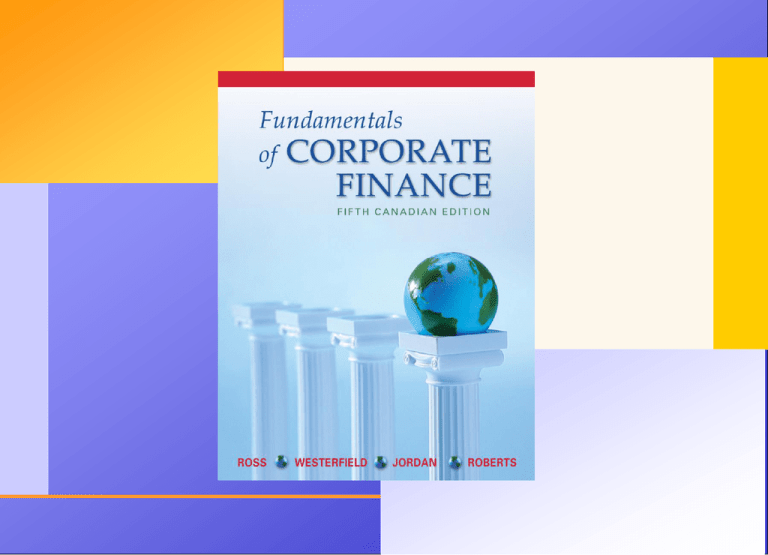
© 2005
McGraw-Hill
Limited
© 2003 The McGraw-Hill
Companies,
Inc. AllRyerson
rights reserved.
Chapter
One
Introduction To
Corporate Finance
© 2003 The McGraw-Hill Companies, Inc. All rights reserved.
1.1
Key Concepts and Skills
• Know the basic types of financial management
decisions and the role of the financial manager
• Know the financial implications of the different forms
of business organization
• Know the goal of financial management
• Understand the conflicts of interest that can arise
between owners and managers
• Understand the various types of financial markets and
financial institutions
• Understand current trends in Canadian financial markets
© 2005 McGraw-Hill Ryerson Limited
1.3
Corporate Finance
• Some important questions that are answered
using finance
– What long-term investments should the firm
undertake?
– Where will we obtain the long-term financing to
pay for the long-term investments?
– How will we manage the day-to-day financial
activities of the firm?
© 2005 McGraw-Hill Ryerson Limited
1.4
Financial Manager
• Financial managers try to answer some or all of
these questions
• The top financial manager within a firm is
usually the Chief Financial Officer (CFO)
– Treasurer – Oversees cash management, capital
expenditures and financial planning
– Controller – Oversees taxes, cost accounting,
financial accounting and data processing
– VP, Corporate Planning/Corporate Development –
What projects should the firm undertake to create
value for the shareholders?
© 2005 McGraw-Hill Ryerson Limited
1.5
Financial Management Decisions
• Capital budgeting
– Provides a framework for making long-term
investment decisions
• Capital structure
– The mix of debt and equity securities on the
Balance Sheet
– Should we use debt or equity (the choice affects
both risk and return)
• Working capital management
– How do we manage the day-to-day finances of the
firm?
© 2005 McGraw-Hill Ryerson Limited
1.6
Forms of Business Organization
• Three major forms in Canada
– Sole proprietorship
– Partnership
• General
• Limited
– Corporation
• In other countries, corporations are also called joint stock
companies, public limited companies and limited liability
companies
© 2005 McGraw-Hill Ryerson Limited
1.7
Sole Proprietorship
• Advantages
– Easiest to start
– Least regulated
– Single owner keeps all
the profits
– Taxed once as personal
income
• Disadvantages
– Unlimited liability
– Limited to life of owner
– Equity capital limited to
owner’s personal wealth
– Difficult to sell
ownership interest
© 2005 McGraw-Hill Ryerson Limited
1.8
Partnership
• Advantages
–
–
–
–
Two or more owners
More capital available
Relatively easy to start
Income taxed once as
personal income
• Disadvantages
– Unlimited liability
• General partnership
• Limited partnership
– Partnership dissolves
when one partner dies or
wishes to sell
– Difficult to transfer
ownership
© 2005 McGraw-Hill Ryerson Limited
1.9
Corporation
• Advantages
– Limited liability
– Unlimited life
– Separation of ownership
and management
– Transfer of ownership is
easy
– Easier to raise capital
• Disadvantages
– Separation of ownership
and management
– Double taxation
(corporate income is first
taxed at the corporate
level. Dividends are
taxed again at the
personal level)
© 2005 McGraw-Hill Ryerson Limited
1.11
Goal Of Financial Management
• What should be the goal of a corporation?
–
–
–
–
Maximize profit?
Minimize costs?
Maximize market share?
Maximize the current value of the company’s
stock?
• Does this mean we should do anything and
everything to maximize the owner’s wealth?
© 2005 McGraw-Hill Ryerson Limited
1.12
Primary Goal of Financial Management
• Three equivalent goals of financial
management:
– Maximize shareholder wealth
– Maximize share price
– Maximize firm value
© 2005 McGraw-Hill Ryerson Limited
1.13
The Agency Problem
• Agency relationship
– Principal hires an agent to represent their interests
– Shareholders (principals) hire managers (agents) to run the
company
• Agency problem
– Conflicts of interest can exist between the principal and the
agent
• Agency costs
– Direct agency costs
• Corporate expenditures that benefit management but not the
shareholders (corporate jets & luxurious offices)
• Expenses incurred to monitor management (hire auditors)
– Indirect agency costs
• Management foregoes a potentially profitable opportunity due
to its potential for a loss of management jobs
© 2005 McGraw-Hill Ryerson Limited
1.14
Managing Managers
• Managerial compensation
– Incentives can be used to align management and stockholder interests
• Example: a portion of pay is tied directly to share price (share purchase options)
or corporate profitability (bonuses)
– The incentives need to be structured carefully to make sure that they
achieve their goal
• Nortel’s incentives led management into making bad decisions
• Corporate control
– The threat of a takeover may result in better management
– The use of “poison pills” protects management at the shareholder’s
expense
• Conflicts with other stakeholders
– A stakeholder in any body with a potential claim on the cash flows of the
organization
– Pressure groups may force the corporation to undertake actions that are not
in the best, short-term interests of the shareholders (employment equity,
environmental issues, etc)
© 2005 McGraw-Hill Ryerson Limited
1.15
Work the Web Example
• The Internet provides a wealth of information
about individual companies
• One excellent site is finance.yahoo.com
• Click on the web surfer to go to the site, choose
a company and see what information you can
find!
© 2005 McGraw-Hill Ryerson Limited
1.16
What is the role of financial markets in corporate finance?
• Cash flows to and from the firm
• Money vs. capital markets
• Primary vs. secondary markets
• How do financial markets benefit society?
© 2005 McGraw-Hill Ryerson Limited
1.17
Cash Flows to and from the Firm
© 2005 McGraw-Hill Ryerson Limited
1.18
Financial Institutions
• Financial institutions act as intermediaries
between suppliers and users of funds
• Institutions earn income on services provided:
– Indirect finance
• Traditional banking – take in deposits & make loans
• Earn interest on the spread between loans and deposits
– Direct finance
• Investment banking – charge a fee in return for
performing a service (i.e. bankers acceptance and
stamping fees)
© 2005 McGraw-Hill Ryerson Limited
1.19
Trends in Financial Markets and Management
•
•
•
•
•
Financial Engineering
Derivative Securities
Advances in Technology – i.e. E-business
Deregulation
Corporate Governance Reform
© 2005 McGraw-Hill Ryerson Limited
1.20
Quick Quiz
• What are the three types of financial
management decisions and what questions are
they designed to answer?
• What are the three major forms of business
organization?
• What is the goal of financial management?
• What are agency problems and why do they
exist within a corporation?
• What is the difference between a primary
market and a secondary market?
© 2005 McGraw-Hill Ryerson Limited
1.21
Summary 1.9
• You should know:
– The advantages and disadvantages between a sole
proprietorship, partnership and corporation
– The primary goal of the firm
– What an agency relationship and cost are
– The role of financial markets
© 2005 McGraw-Hill Ryerson Limited




